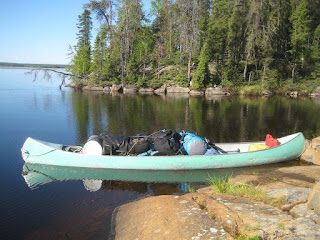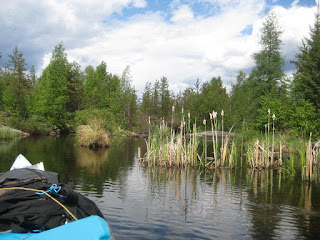Two Week (14 day) Grub Menu for 2019
For one trip, I can typically take enough grub for three months.
All grocery supplies are off-the-shelf items.
I drink hot water alone with supper, and cold or hot water for other meals. Water is sterilized by boiling for one minute or by a filtration system. The latter removes bacteria and parasites (but not viruses, so is technically not sterilized).
Breakfast - 7 days:
scotch mint
Premier Protein™ bar 72g (30g protein)
seed mixture 1/4c (hemp hulled, chia, buckwheat toasted, pumpkin hulled roasted salted)
peanut butter smooth 1tbsp
vitamins
Breakfast - 4 days:
scotch mint
1/2 hot cinnamon bannock (See below.)
grated Parmesan cheese 1/4c
real bacon crumbled 1/4c
vitamins
Breakfast - 3 days:
scotch mint
1/2 hot cinnamon bannock
seed mixture 1/4c
peanut butter smooth 1tbsp
vitamins
Lunch - 7 days:
scotch mint
1/4 cold cinnamon bannock
almonds roasted salted 1/4c
Mini Babybel™ cheese 20g (stores well in its wax cover unrefrigerated if wrapped to protect from damage)
Premier Protein™ bar 72g
gum
Lunch - 7 days:
scotch mint
1/4 cold cinnamon bannock
almonds roasted salted 1/4c
Mini Babybel™ cheese 20g
gum
Plus for Lunch - 3 days:
granola bar Nature Valley™ Sweet & Sour 35g
Supper - daily:
scotch mint
white chocolate square 42g (Even though I pre-tested, after I tried eating it for a few meals with no success, ended up burning my supply )
fresh salad 3c (fireweed, or alder or birch leaves/catkins)
(with sugar 1tbsp, lemon pepper seasoning 1tsp, grated Parmesan cheese 1/4c)
fresh fruit if available 1c
(lingonberries, bunchberries, blueberries, red currants, raspberries, highbush cranberries, cloudberries, rose hips, Saskatoon berries, pin cherries, crowberries, bilberries)
Supper - 10 days:
macaroni and real cheese 2c (Kraft™ Deluxe Four Cheese or Original Cheddar 400g)
OR both of the following
potato flakes 1c, or bulgur, whole wheat couscous or orzo 3/4c (plus nutritional yeast 1tbsp, chicken soup mix 1tbsp, and butter 2tbsp)
sardines 106g or canned meat 85g portion (corned beef or Holiday™ Luncheon)
Supper - 4 days:
stuffing mix 120g with butter 2tbsp, or oriental noodles 170g
PLUS one of the following
fish coated (cornmeal 1/8c, Montreal steak spice 1tbsp), fried in Crisco™ shortening (1/2lb saved and used over a period of two weeks)
OR
fish diced, boiled and added to the potato flakes (or to the noodles)
OR
small game (roasted over coals, or meat sliced and sautéed in shortening 1tbsp)
NOTE:
Starting in 2019, I have boosted the content of the cinnamon bannock so it is even more nutritious and filling, however it is not as tasty and may not be suitable for some people. My wife Jeanette made me test bake it at home before switching to whole wheat flour; she did not like the new recipe. Previous recipes back through 2013 each have fewer ingredients and lower concentrations of some items so the older the recipe the tastier, and more like bakery food. My intent is to reduce the instances of being hungry enough to eat a jackass stuffed with firecrackers.
I will no longer take currant bannock so that meal preparation will be easier and faster, especially in inclement weather.
Cinnamon bannock:
3c premixed before the trip (whole wheat flour 1c, Purity® cornmeal 1/4c, quick rolled oats 1/4c, whole wheat couscous 1/4c, skim milk powder 1/4c, dark toasted wheat germ 2tbsp, white wheat bran 2tbsp, baking powder 2tsp, salt 1/2tsp, sugar 1tsp, Crisco™ shortening 6tbsp)
The dough is split into two layers, between which is added raisins 1/4c, cinnamon 1tbsp, brown sugar 1/4c, butter 3oz (3/8c). A large tart is formed and then baked in Dutch oven.
For one trip, I can typically take enough grub for three months.
All grocery supplies are off-the-shelf items.
I drink hot water alone with supper, and cold or hot water for other meals. Water is sterilized by boiling for one minute or by a filtration system. The latter removes bacteria and parasites (but not viruses, so is technically not sterilized).
Breakfast - 7 days:
scotch mint
Premier Protein™ bar 72g (30g protein)
seed mixture 1/4c (hemp hulled, chia, buckwheat toasted, pumpkin hulled roasted salted)
peanut butter smooth 1tbsp
vitamins
Breakfast - 4 days:
scotch mint
1/2 hot cinnamon bannock (See below.)
grated Parmesan cheese 1/4c
real bacon crumbled 1/4c
vitamins
Breakfast - 3 days:
scotch mint
1/2 hot cinnamon bannock
seed mixture 1/4c
peanut butter smooth 1tbsp
vitamins
Lunch - 7 days:
scotch mint
1/4 cold cinnamon bannock
almonds roasted salted 1/4c
Mini Babybel™ cheese 20g (stores well in its wax cover unrefrigerated if wrapped to protect from damage)
Premier Protein™ bar 72g
gum
Lunch - 7 days:
scotch mint
1/4 cold cinnamon bannock
almonds roasted salted 1/4c
Mini Babybel™ cheese 20g
gum
Plus for Lunch - 3 days:
granola bar Nature Valley™ Sweet & Sour 35g
Supper - daily:
scotch mint
white chocolate square 42g (Even though I pre-tested, after I tried eating it for a few meals with no success, ended up burning my supply )
fresh salad 3c (fireweed, or alder or birch leaves/catkins)
(with sugar 1tbsp, lemon pepper seasoning 1tsp, grated Parmesan cheese 1/4c)
fresh fruit if available 1c
(lingonberries, bunchberries, blueberries, red currants, raspberries, highbush cranberries, cloudberries, rose hips, Saskatoon berries, pin cherries, crowberries, bilberries)
Supper - 10 days:
macaroni and real cheese 2c (Kraft™ Deluxe Four Cheese or Original Cheddar 400g)
OR both of the following
potato flakes 1c, or bulgur, whole wheat couscous or orzo 3/4c (plus nutritional yeast 1tbsp, chicken soup mix 1tbsp, and butter 2tbsp)
sardines 106g or canned meat 85g portion (corned beef or Holiday™ Luncheon)
Supper - 4 days:
stuffing mix 120g with butter 2tbsp, or oriental noodles 170g
PLUS one of the following
fish coated (cornmeal 1/8c, Montreal steak spice 1tbsp), fried in Crisco™ shortening (1/2lb saved and used over a period of two weeks)
OR
fish diced, boiled and added to the potato flakes (or to the noodles)
OR
small game (roasted over coals, or meat sliced and sautéed in shortening 1tbsp)
NOTE:
Starting in 2019, I have boosted the content of the cinnamon bannock so it is even more nutritious and filling, however it is not as tasty and may not be suitable for some people. My wife Jeanette made me test bake it at home before switching to whole wheat flour; she did not like the new recipe. Previous recipes back through 2013 each have fewer ingredients and lower concentrations of some items so the older the recipe the tastier, and more like bakery food. My intent is to reduce the instances of being hungry enough to eat a jackass stuffed with firecrackers.
I will no longer take currant bannock so that meal preparation will be easier and faster, especially in inclement weather.
Cinnamon bannock:
3c premixed before the trip (whole wheat flour 1c, Purity® cornmeal 1/4c, quick rolled oats 1/4c, whole wheat couscous 1/4c, skim milk powder 1/4c, dark toasted wheat germ 2tbsp, white wheat bran 2tbsp, baking powder 2tsp, salt 1/2tsp, sugar 1tsp, Crisco™ shortening 6tbsp)
The dough is split into two layers, between which is added raisins 1/4c, cinnamon 1tbsp, brown sugar 1/4c, butter 3oz (3/8c). A large tart is formed and then baked in Dutch oven.









































































